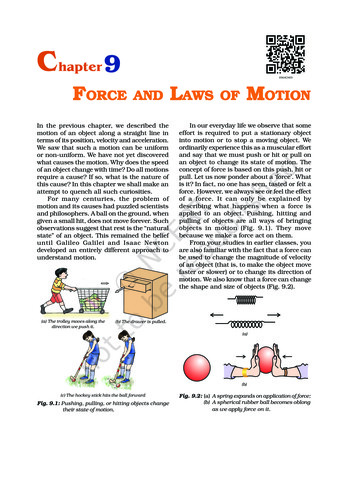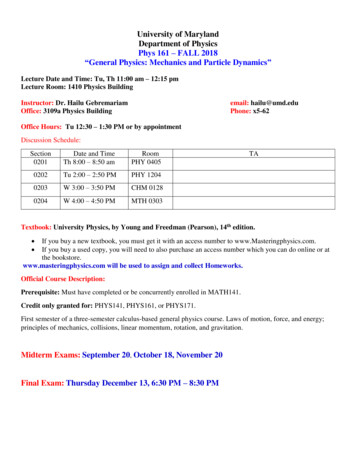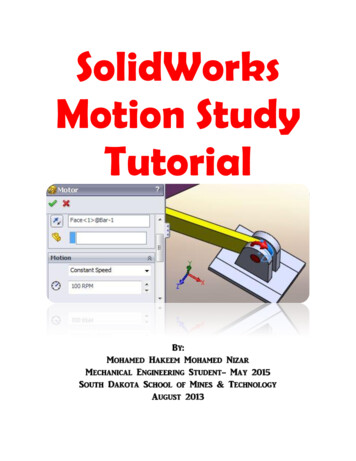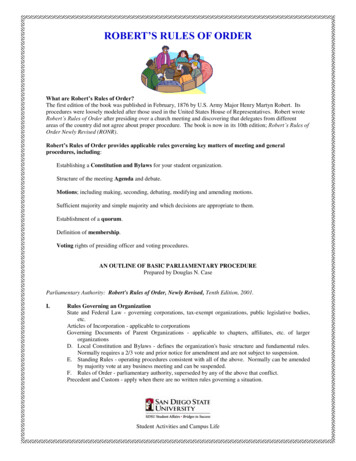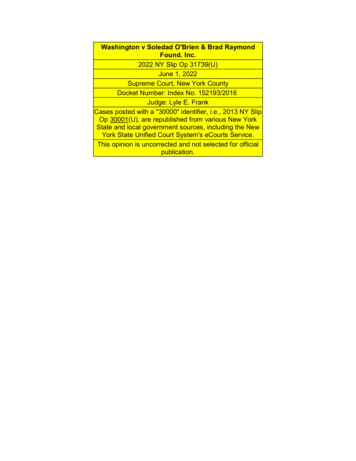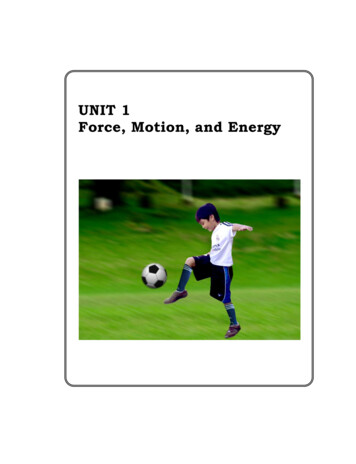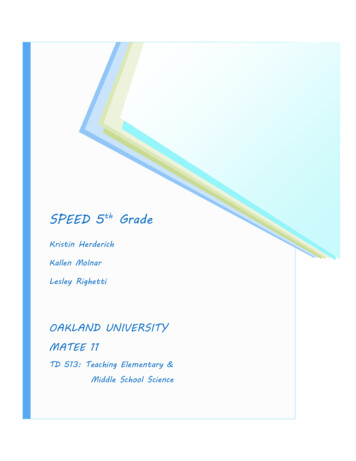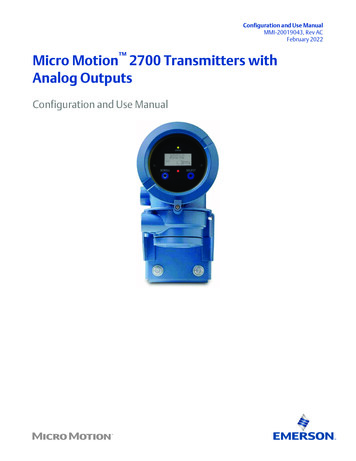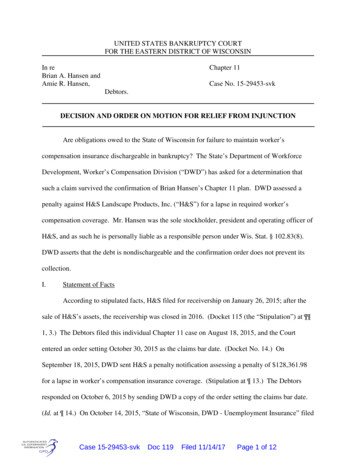
Transcription
UNITED STATES BANKRUPTCY COURTFOR THE EASTERN DISTRICT OF WISCONSINIn reBrian A. Hansen andAmie R. Hansen,Chapter 11Case No. 15-29453-svkDebtors.DECISION AND ORDER ON MOTION FOR RELIEF FROM INJUNCTIONAre obligations owed to the State of Wisconsin for failure to maintain worker’scompensation insurance dischargeable in bankruptcy? The State’s Department of WorkforceDevelopment, Worker’s Compensation Division (“DWD”) has asked for a determination thatsuch a claim survived the confirmation of Brian Hansen’s Chapter 11 plan. DWD assessed apenalty against H&S Landscape Products, Inc. (“H&S”) for a lapse in required worker’scompensation coverage. Mr. Hansen was the sole stockholder, president and operating officer ofH&S, and as such he is personally liable as a responsible person under Wis. Stat. § 102.83(8).DWD asserts that the debt is nondischargeable and the confirmation order does not prevent itscollection.I.Statement of FactsAccording to stipulated facts, H&S filed for receivership on January 26, 2015; after thesale of H&S’s assets, the receivership was closed in 2016. (Docket 115 (the “Stipulation”) at ¶¶1, 3.) The Debtors filed this individual Chapter 11 case on August 18, 2015, and the Courtentered an order setting October 30, 2015 as the claims bar date. (Docket No. 14.) OnSeptember 18, 2015, DWD sent H&S a penalty notification assessing a penalty of 128,361.98for a lapse in worker’s compensation insurance coverage. (Stipulation at ¶ 13.) The Debtorsresponded on October 6, 2015 by sending DWD a copy of the order setting the claims bar date.(Id. at ¶ 14.) On October 14, 2015, “State of Wisconsin, DWD - Unemployment Insurance” filedCase 15-29453-svkDoc 119Filed 11/14/17Page 1 of 12
a proof of claim for 32,295.58. DWD did not file a proof of claim for the worker’scompensation debt.On June 2, 2016, the Court confirmed the Debtors’ plan. (Docket No. 84.) The planexpressly addressed the claims filed by DWD’s Unemployment Insurance Division and theWisconsin Department of Revenue. (Docket No. 66-1 at ¶ 3.2(b).) The plan provided forgeneral unsecured creditors to receive annual installments equal to the reorganized Debtors’disposable income. (Id. at ¶ 3.4.) It also contained a statement that the confirmation order wouldprovide that creditors were enjoined from enforcing their claims after the effective date, but theCourt’s order did not contain an injunction. (Id. at ¶ 8.2.)On May 12, 2017, DWD filed the instant Motion for Relief from Injunction. DWDargues that the injunction anticipated in the plan is ineffective, and any injunction contained inthe plan is void. Bankruptcy Rule 3020(c)(1) states that if a plan “provides for an injunctionagainst conduct not otherwise enjoined under the Code, the order of confirmation shall (1)describe in reasonable detail all acts enjoined; (2) be specific in its terms regarding theinjunction; and (3) identify the entities subject to the injunction.” The confirmation order in thiscase contains no such language. If the injunction is valid, DWD alternatively seeks relief fromthe injunction, claiming that it violates the Bankruptcy Code in essentially dischargingnondischargeable debts by permanently enjoining their collection.The Debtors argue that the debt owed to DWD based on H&S’s failure to maintainworker’s compensation insurance is dischargeable and that another division of DWD filed aproof of claim. According to the Debtors, the only way for DWD to pursue the claim is byamending the proof of claim filed by the Unemployment Insurance Division or filing a newclaim, which it cannot do following confirmation and substantial consummation of the plan.2Case 15-29453-svkDoc 119Filed 11/14/17Page 2 of 12
II.Jurisdiction and Procedural MattersThe Debtors suggest that DWD’s motion was precipitated by a notice of levy on a bankaccount owned by Russ’s Mulch & Topsoil, Inc., one of Mr. Hansen’s companies. They assertthat DWD cannot collect its claim from Russ’s Mulch or Four Seasons Landscaping &Maintenance of Brookfield, LLC, another one of Mr. Hansen’s companies. They request that theCourt “order that DWD is prohibited from collecting in any manner from Russ’s Mulch or FourSeasons, including levies on their bank accounts.” (Docket No. 117 at 4.) The Debtorsemphasize that plan payments to unsecured creditors are funded from the operations of thesecompanies, and that any collection from Russ’s Mulch would interfere with their performanceunder the plan. But neither Russ’s Mulch nor Four Seasons Landscaping filed bankruptcy. TheDebtors offer no argument as to how the Court has jurisdiction to enter an order enjoiningcollection efforts against these non-debtor entities, and DWD notes that it is prosecuting a claimonly against Mr. Hansen. (Docket No. 118 at 1.) Given the jurisdictional issues, whether Mr.Hansen’s other companies are liable for DWD’s claim against H&S or Mr. Hansen is beyond thescope of this decision.A proceeding to determine the dischargeability of debt is a core proceeding under 28U.S.C. § 157(b)(2)(A) and (I). The Court has jurisdiction pursuant to 28 U.S.C. § 1334 and theorder of reference entered pursuant to 28 U.S.C. § 157(a). Bankruptcy Rule 7001(6) providesthat a proceeding to determine the dischargeability of a debt is an adversary proceeding.However, parties may waive this requirement. See, e.g., In re Mark Twain Marine Indus., Inc.,115 B.R. 948, 949 n.1 (Bankr. N.D. Ill. 1990) (finding parties waived the right to an adversaryproceeding and deciding matter by way of motion “[i]n the interest of saving both partiesadditional costs and expenses attendant to a formal adversary proceeding, and in the interest ofjudicial economy.”). Here, counsel for the parties have agreed that “the most cost-effective and3Case 15-29453-svkDoc 119Filed 11/14/17Page 3 of 12
efficient way to resolve the motion is in a summary-judgment type manner. The facts likely arenot in dispute and the issue would likely be a legal one that the Court could decide on briefs.”(Debtors’ Objection, Docket No. 108 at 2.)III.Confirmation of the Plan Binds Creditors Owed Dischargeable DebtsThe parties disagree on the effect of the injunction described in the plan. The plan states:“The Confirmation Order will provide, inter alia, that, except as otherwise provided for in thePlan, all Persons who have held, hold or may hold Claims are permanently enjoined from andafter the Effective Date from” certain collection activities. (Docket No. 66-1 at ¶ 8.2.)However, the order contains no such injunction. Bankruptcy Rule 3020(c) also states that if aplan provides for an injunction against conduct not enjoined under the Bankruptcy Code, theconfirmation order should address the injunction in a certain manner. But the Court need notreach the issue of the validity of the phantom injunction, since even if the plan and confirmationorder contained such an injunction, it would not be effective to enjoin the collection of anondischargeable debt. See McClendon v. Springfield, 505 B.R. 786, 793 (E.D. Tex. 2013) (planinjunction did not bar creditor from pursuing declaration of nondischargeability). Instead, theBankruptcy Code itself governs the rights of creditors after confirmation of a Chapter 11 plan.Bankruptcy Code § 1141(a) provides:Except as provided in subsections (d)(2) and (d)(3) of this section, the provisionsof a confirmed plan bind the debtor, any entity issuing securities under the plan,any entity acquiring property under the plan, and any creditor, equity securityholder, or general partner in the debtor, whether or not the claim or interest ofsuch creditor, equity security holder, or general partner is impaired under the planand whether or not such creditor, equity security holder, or general partner hasaccepted the plan.Thus, a confirmed plan generally binds creditors who do not even participate in the Chapter 11case, which would include the Worker’s Compensation Division of DWD in this case. See 11U.S.C. §§ 101(10) (definition of “creditor”), 101(5) (definition of “claim”). This binding effect4Case 15-29453-svkDoc 119Filed 11/14/17Page 4 of 12
is tempered by notions of due process. See Sequa Corp. v. Christopher (In re Christopher), 28F.3d 512 (5th Cir. 1994) (actual notice of bankruptcy is required before plan binds creditor); ShuLun Wu v. May Kwan Si, Inc., 508 B.R. 606 (S.D.N.Y. 2014) (creditor of individual debtor notbound by plan where creditor did not receive notice of claims bar date). Here, there is no disputethat DWD – and in fact the Worker’s Compensation Division of DWD – received actual noticeof the claims bar date. (Stipulation at ¶ 14.) Another division of DWD responded by filing atimely proof of claim. Accordingly, DWD is bound by the terms of the confirmed plan, exceptas provided in subsection (d)(2) or (d)(3) of § 1141.Section 1141(d)(2) may apply to preserve DWD’s collection rights against Mr. Hansen.That exception states that an individual debtor does not receive a discharge of debts excludedfrom discharge under § 523. If Mr. Hansen’s debt to DWD for the worker’s compensationpenalty is nondischargeable, then DWD is not bound by the plan and may continue with itscollection efforts.The court faced a similar set of facts in Grynberg v. United States (In re Grynberg), 986F.2d 367 (10th Cir. 1993). In that case, the Chapter 11 debtors scheduled the United States as adisputed creditor for income and gift taxes. The IRS filed a timely proof of claim for the incometax liability, but did not file a proof of claim for the gift tax liability, which wasnondischargeable as an excise tax. After consummation of the debtors’ plan, the IRS sent anotice of proposed deficiency and penalties, and the debtors filed an adversary proceeding toenjoin collection of the gift tax debt. The debtors cited numerous cases “emphasizing the finalityof bar orders and prohibiting the IRS from filing additional proofs of claim after the bar date haspassed.” Id. at 370. The Tenth Circuit Court of Appeals rejected their argument. “These casesestablish only that the IRS is bound to submit its proofs of claim like any other creditor or beforeclosed from participating in the debtor’s reorganization. However, like any other holder of a5Case 15-29453-svkDoc 119Filed 11/14/17Page 5 of 12
nondischargeable debt, the IRS is also free to pursue the debtor outside bankruptcy.” Id. Thesame is true here if the debt to DWD is nondischargeable. The fact that DWD did not file aproof of claim for the debt at issue precludes DWD from receiving a distribution under theDebtors’ plan. But § 1141(a) would not bar DWD from ignoring the plan and recovering on itsclaim if the debt is nondischargeable.IV.Dischargeability of DebtDWD argues the debt is nondischargeable under 11 U.S.C. § 523(a)(7) as a penalty orunder § 523(a)(1)(A) as an excise tax. Exceptions to discharge are construed liberally in favor ofthe Debtors. See In re Scarlata, 979 F.2d 521, 524 (7th Cir. 1992). As the party seeking adetermination that a debt is nondischargeable, DWD must prove the elements of one of theexceptions by a preponderance of the evidence. See Grogan v. Garner, 498 U.S. 279 (1991).The debt at issue here stems from H&S’s failure to carry worker’s compensationinsurance as required by Wisconsin law. See Wis. Stat. § 102.28(2)(a). There are twoconsequences if an employer fails to carry insurance. First, under Wis. Stat. § 102.82(1), theemployer must reimburse the DWD for any payment made on an employee’s or dependent’sclaim. Second, the employer must pay the greater of1. Twice the amount determined by the department to equal what the uninsuredemployer would have paid during periods of illegal nonpayment for worker’scompensation insurance in the preceding 3-year period based on the employer’spayroll in the preceding 3 years.2. Seven hundred and fifty dollars.Wis. Stat. § 102.82(2)(a). Both reimbursement payments under § 108.82(1) and “lapse-only”payments under § 108.82(2)(a) are placed in a fund called the Uninsured Employers Fund(“UEF”) and are only used to make payments to injured employees of uninsured employers andpossibly for reinsurance. See Wis. Stat. § 102.80(1)(a), (1m); see also Wis. Stat.6Case 15-29453-svkDoc 119Filed 11/14/17Page 6 of 12
§ 20.445(1)(sm). This case involves a lapse-only payment, not a payment for reimbursement ofan injured employee. (Stipulation at ¶ 13.)A.The Debt is Not an Excise Tax That Would be Nondischargeable under 11 U.S.C.§ 523(a)(1)(A)A debt for a priority tax specified in Bankruptcy Code § 507(a)(8) is nondischargeableunder § 523(a)(1)(A). Section 507(a)(8)(E) provides priority for an “excise tax” on transactionsduring designated time periods. “The term ‘excise tax’ is not defined in the Bankruptcy Code,but included are estate and gift, sales, franchise, occupation, gasoline, truck, and special fueltaxes. Black’s Law Dictionary defines the term as ‘A tax imposed on the manufacture, sale oruse of goods (such as a cigarette tax), or on an occupation or activity (such as a license tax or anattorney occupation fee).’” Susan V. Kelley, Ginsberg & Martin on Bankruptcy § 18.06[I][5](5th ed. Supp. 2017) (citations omitted).In United States v. Reorganized CF&I Fabricators, 518 U.S. 213 (1996), the SupremeCourt reviewed the priority of a debt imposed under a section of the Internal Revenue Code titled“Miscellaneous Excise Taxes” for the debtor’s failure to maintain a fully funded pension plan.The Court said: “A tax is an enforced contribution to provide for the support of government; apenalty, as the word is here used, is an exaction imposed by statute as punishment for anunlawful act.” 518 U.S. at 224 (quoting United States v. La Franca, 282 U.S. 568, 572 (1931)).The Court determined this “statement of the distinction to be sufficient for the decision of thiscase; if the concept of penalty means anything, it means punishment for an unlawful act oromission, and a punishment for an unlawful omission is what this exaction is.” Id. Given the7Case 15-29453-svkDoc 119Filed 11/14/17Page 7 of 12
punitive nature of the “tax” for failing to maintain the pension funding, the Court held it was notan excise tax entitled to priority.This reasoning in CF&I applies here. The alleged excise tax was only imposed becauseH&S failed to maintain worker’s compensation coverage in violation of the law, just as the tax inCF&I was imposed for the debtor’s failure to maintain a fully funded pension account. DWDadmits the punitive nature of the obligation, conceding that the obligation operates only as apenalty and does not serve a compensatory purpose because the State does not purchasesubstitute insurance. (Docket No. 116 at 4.)Cases such as California Self-Insurers Security Fund v. Lorber Industries (In re LorberIndustries), 564 F.3d 1098 (9th Cir. 2009) (California Self-Insurers’ Security Fund claim was notan excise tax); New Neighborhoods, Inc. v. West Virginia Workers’ Compensation Fund, 886F.2d 714 (4th Cir. 1989) (worker’s compensation premiums due the State are priority excisetaxes); and Yoder v. Ohio Bureau of Workers’ Compensation (In re Suburban Motor Freight),998 F.2d 338 (6th Cir. 1993) (same) are distinguishable. These cases construe obligations for adebtor’s failure to pay either reimbursement claims for an injured worker or premiums to theState for compulsory worker’s compensation coverage provided by the State. They do notinvolve a penalty imposed by a State for a debtor’s failure to maintain private worker’scompensation insurance. This case involves such a penalty, and the Court’s analysis is guidedby CF&I. Since the function of the obligation here is not to support the government but rather topunish the Debtor for his company’s failure to maintain worker’s compensation coverage, theobligation is a penalty, not an excise tax.B.The Debt is Not a Nondischargeable Penalty under 11 U.S.C. § 523(a)(7)Having concluded that DWD’s claim is not nondischargeable as an excise tax, the issue iswhether it is a nondischargeable penalty under 11 U.S.C. § 523(a)(7). To qualify under this8Case 15-29453-svkDoc 119Filed 11/14/17Page 8 of 12
subsection, a debt must be (1) a fine, penalty, or forfeiture; (2) payable to and for the benefit of agovernmental unit; (3) not compensation for actual pecuniary loss; and (4) not a specified taxpenalty. The first, third, and fourth requirements are satisfied here. The statute penalizesemployers for failure to maintain insurance by charging them certain amounts. A lapse-onlypayment is also not compensation for actual pecuniary loss. The State did not have to pay anyclaims to injured employees of H&S, and DWD admits that the “State does not purchasesubstitute insurance when a lapse in coverage occurs” so the “charges do not repay the State forthe cost of any such substitute insurance.” (Docket No. 116 at 4.) The debt is also payable to agovernmental unit, satisfying part of the second requirement.However, it is less clear that the debt is payable for the benefit of a governmental unit. InKelly v. Robinson, 479 U.S. 36 (1986), the Supreme Court held that restitution imposed by astate criminal court as part of a criminal sentence falls within this exception to discharge. InKelly, the Court determined the restitution was payable to and for the benefit of a governmentalunit because “criminal proceedings focus on the State’s interests in rehabilitation andpunishment, rather than the victim’s desire for compensation.” Thus, the restitution orderoperated “for the benefit of” the State. Kelly, 479 U.S. at 53.Subsequently, the Seventh Circuit Court of Appeals held that certain civil restitution wasnot covered by § 523(a)(7). In re Towers, 162 F.3d 952 (7th Cir. 1998). In Towers, the courtdetermined that a civil restitution order obtained by the Attorney General of Illinois on behalf offraud victims under the Illinois Consumer Fraud and Deceptive Business Practices Act did notcome within the exception. It was not payable to and for the benefit of a governmental unit. Astate statute and court order suggested that the Attorney General was required to disburse thefunds to victims, and the court characterized this as the governmental body “collecting forprivate creditors.” Id. at 954. The Seventh Circuit recognized that the restitution may have a9Case 15-29453-svkDoc 119Filed 11/14/17Page 9 of 12
benefit to citizens in deterring fraud, but the court read § 523(a)(7) to suggest that thegovernmental unit ought to receive a financial benefit. The court observed that “neither thepeople of Illinois nor any governmental unit receives a financial benefit from the restitution thatTowers has been directed to pay, and the ‘governmental unit’ does not receive any benefit fromgeneral deterrence either.” Id. at 956. Under Towers, courts should not interpret “benefit” in§ 523(a)(7) to include “generalized positive public effect.” Kish v. Farmer (In re Kish), 238B.R. 271, 286-87 (Bankr. D.N.J. 1999). Otherwise, it “would distort the meaning of section523(a)(7) to bring within its coverage any and all monetary obligations which may in some wayinure to the general welfare of the state’s citizens.” Id.In this case, the Debtors argue that the penalty is not payable for the benefit of agovernmental unit because the funds are paid to the Uninsured Employers Fund, and these fundscan only be spent to benefit injured employees or to buy reinsurance to pay those claims. DWDargues that although the funds in the UEF are ultimately paid out to injured employees or forreinsurance, payments to the Fund “also offer a benefit to the state: they assure that DWD cancompensate the injured employees without dipping into other funds.” (Docket No. 118 at 4.)According to DWD, the State’s purpose in receiving the funds is to defray the cost of worker’scompensation for injured employees of Wisconsin’s uninsured employers “without devotingother state resources to that end.” (Id.)The Debtors make the more persuasive argument. New Jersey Department of Labor &Workforce Development, Office of Special Compensation Funds v. Moran-Hernandez (In reMoran-Hernandez), 544 B.R. 796 (Bankr. D.N.J. 2016) is directly on point. In that case, theState assessed a penalty against the debtor for failure to maintain worker’s compensationinsurance. A New Jersey statute permitted the State to use some money from the uninsuredemployer’s fund for administrative expenses, as long as the total amount did not exceed 10,00010Case 15-29453-svkDoc 119Filed 11/14/17Page 10 of 12
during any fiscal year. However, even though the State pointed to its ability to use some of thepenalty for State expenses, the court denied the State’s summary judgment motion, requiring it todemonstrate that the state budget authorized it to use the penalties assessed in the relevant fiscalyear for operations.Another bankruptcy court in the district, in an unpublished opinion, had previouslydetermined on reconsideration that the penalty was not payable for the benefit of a governmentalunit, notwithstanding the fact that the statute allocated a small portion of it to administrativecosts. See In re Hurtado, No. 10-48668 (DHS), 2015 Bankr. LEXIS 292 (Bankr. D.N.J. Jan. 29,2015). (The Debtors cited the bankruptcy court’s original opinion, designated not forpublication, in their brief.) According to this court, the clear legislative intent of the statute wasto provide payment to claimants, not to fund administrative operations. The fact that such asmall portion of the penalty could be used for operations indicated that the legislature intendedthe penalties “to be used, almost exclusively, to benefit injured employees and not thegovernment.” Id. at *11.Here, no portion of the penalty can be used to fund State operations. Rather, the fundsfrom Wisconsin’s UEF are used solely to make payments to injured employees of uninsuredemployers and possibly for excess or stop-loss reinsurance. See Wis. Stat. §§ 102.80; 102.81(2);20.445(1)(sm). In fact, Wis. Stat. § 102.80 establishes the fund as a “separate, nonlapsible trustfund” confirming that payments made to the UEF are held for the benefit of injured workers, notthe State. DWD suggests that the UEF furthers a legitimate state purpose, not that the Statereceives anything beyond a benefit to the general welfare of its citizens. Under Towers andMoran-Hernandez, this generalized benefit does not qualify as a penalty payable for the benefitof a governmental unit. Accordingly, the debt does not fall within § 523(a)(7)’s exception todischarge and is dischargeable.11Case 15-29453-svkDoc 119Filed 11/14/17Page 11 of 12
V.ConclusionDWD received notice of the claims bar date in the Debtors’ Chapter 11 case, and one ofits divisions responded by filing a proof of claim. The Worker’s Compensation Division did notfile a claim, and ran the risk that its claim would be determined to be dischargeable. By virtue of§ 1141(a) and (d)(2), collection of a nondischargeable debt does not violate a confirmed plan.But the only two potentially applicable discharge exceptions, for excise taxes andnoncompensatory penalties, do not apply. Accordingly, DWD is bound by the terms of theconfirmed plan, and cannot pursue collection from Mr. Hansen. Assuming the Debtors completethe payments under the Chapter 11 plan or qualify for a hardship discharge, they will receive adischarge under § 1141(d)(5) that will include Mr. Hansen’s personal liability for H&S’s unpaidworker’s compensation penalties.IT IS THEREFORE ORDERED: DWD’s Motion is denied.Dated: November 14, 201712Case 15-29453-svkDoc 119Filed 11/14/17Page 12 of 12
only against Mr. Hansen. (Docket No. 118 at 1.) Given the jurisdictional issues, whether Mr. Hansen's other companies are liable for DWD's claim against H&S or Mr. Hansen is beyond the scope of this decision. A proceeding to determine the dischargeability of debt is a core proceeding under 28 U.S.C. § 157(b)(2)(A) and (I).


